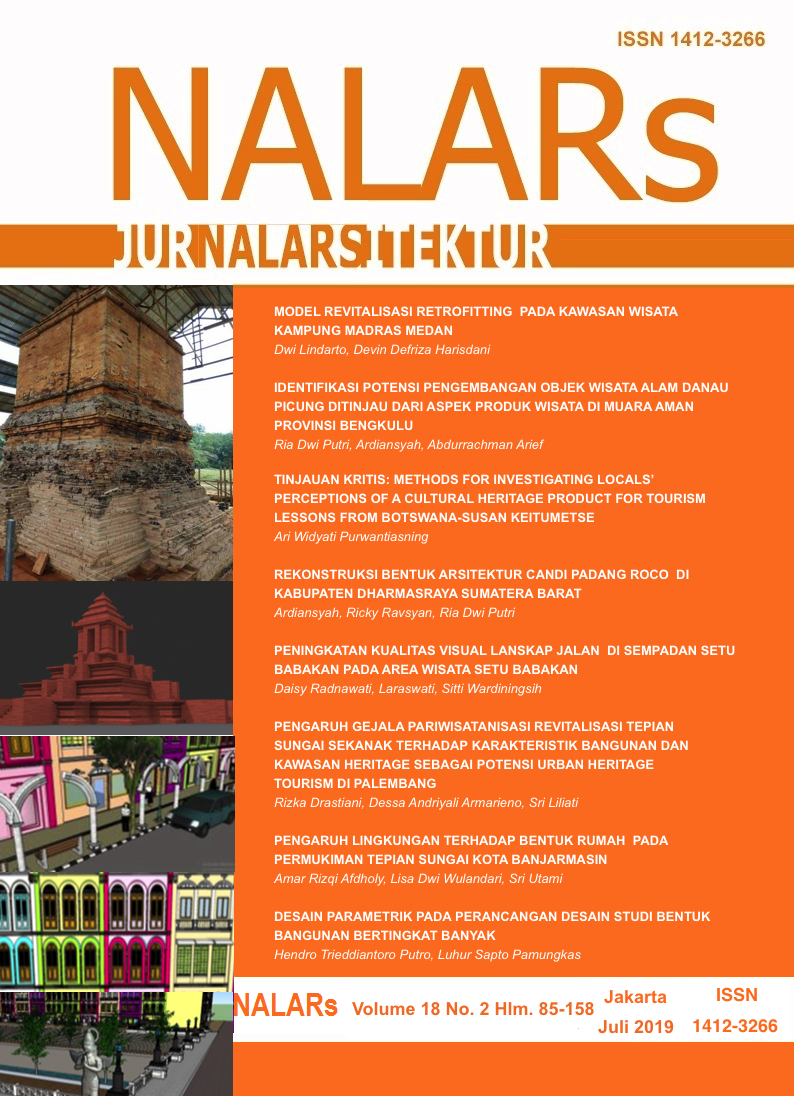REKONSTRUKSI BENTUK ARSITEKTUR CANDI PADANG ROCO DI KABUPATEN DHARMASRAYA SUMATERA BARAT
DOI:
https://doi.org/10.24853/nalars.18.2.105-118Abstract
Abstrak. Penelitian rekonstruksi bentuk Candi di Sumatera perlu dilakukan dikarenakan Candi di Sumatera umumnya hanya tersisa bagian kaki, sehingga penelitian mengenai langgam dan terkait budaya sulit dilakukan. Selain itu kajian pemaknaan bentuk dan perumusan langgam arsitektur candi perlu dilakukan kajian morfologi terlebih dahulu. Permasalahan yang dijumpai pada situs percandian di Sumatera adalah tidak semua candi di Sumatera memiliki bentuk yang utuh melainkan mayoritas hanya menyisakan bagian dasar candi dan paling lengkap hanya badan candi, hal ini apabila dibiarkan maka masalah ini akan tetap mengambang tanpa ada solusi ke depan. Berdasarkan permasalahan tersebut diperlukan kajian tafsiran bentuk candi secara utuh. Dari beberapa penelitian umumnya menggunakan metode komparasi dengan melihat bangunan-bangunan candi di Indonesia akan tetapi metode urutan rekonstruksi bentuk tidak begitu rinci, di dalam penelitian ini metode yang digunakan adalah metode kualitatif dan bersifat penelitian lapangan. Adapun analisis data yang dilakukan menggunakan analisis morfologi dan komparasi, data hasil pengukuran candi Padang Roco dirumuskan angka perbandingannya. Berdasarkan hasil rekonstruksi ditemukan bahwa bentuk Candi Padang Roco memiliki gaya arsitektur yang berbeda dari candi di Indonesia pada umumnya mulai dari bentuk punden berundak seperti tipe candi di Indo-Cina. Bentuk candi ini juga serupa dengan keberadaan struktur kuno yang berbentuk punden berundak yang ditemukan di Lampung dan memiliki analogi dengan perabotan tradisional di Palembang juga serupa dengan punden berundak.Kata Kunci : Rekonstruksi, Bentuk, Proporsi, Candi ABSTRACT. Research on the reconstruction of temple form in Sumatera needs to be done because the temples in Sumatera generally only left with the base of the temple, so research on culture and culture-related is difficult. Besides that, the study of the meaning of the form and formulation of the temple architectural style needs to be carried out morphological study first. The problem encountered in the ensemble site in Sumatera is that not all of them have a complete form, but the majority only leaves the leg and most complete only the body parts of the temple. This problem will remain floating without any future solutions. Based on these problems, the researchers tried to begin by enlightening the study of how the interpretation of the temple form, which left the foot of the temple became the appearance of the temple as a whole. From several studies generally using the comparative method by looking at temple buildings in Indonesia but the purpose of explanation of the order of the reconstruction process is not very detailed, in this study the method used is qualitative and is field research. As for the data analysis carried out using morphological and comparative analysis, the data from the measurement of Padang Roco temple were compared. Based on the result of the reconstruction it was found that the shape of the Padang Roco temple had a different architectural style from the temples in Indonesia, in general, ranging from the form of Punden terraces such as the type of temple in Indo-China. The shape of the temple is also similar to the existence of ancient structure in the form of Punden terrace found in Lampung and have an analogy with traditional furniture in Palembang which is also identical to Punden form.Keywords : Reconstruction, Form, Proportion, CandiDownloads
Published
2019-06-30
Issue
Section
Articles


